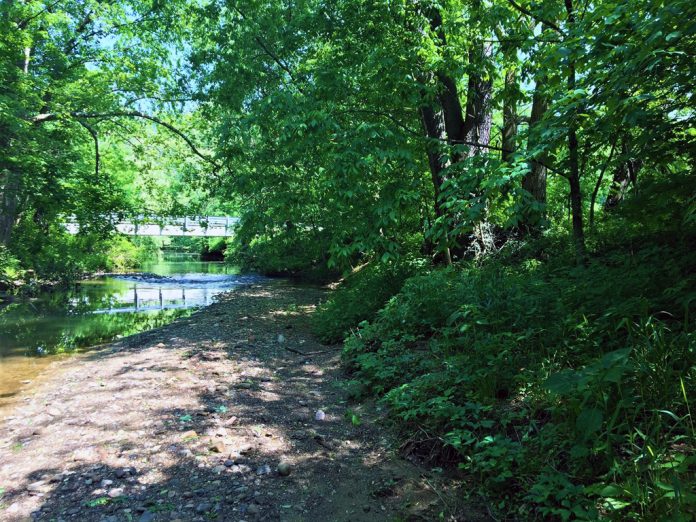By Taylor Hillyer | Portage County Soil and Water Conservation District
When you think perennial crops, orchards likely come to mind. Apples, pears, peaches, oh my!
However, perennial crops are diverse and offer a wide range of benefits.
Due to their perennial nature, these crops can be huge partners in soil health and water quality since the ground they are grown on is not disturbed on an annual basis. This allows for soil structure to form, which helps to reduce stormwater runoff and sediment erosion.
These benefits are good for us all, and we haven’t even gotten to the tasty part. There are a wide variety of perennial crop options that are suitable for this region, and they can be incorporated into our landscapes in a variety of ways.
Agroforestry is the intentional integration of trees and shrubs into crop and animal farming systems. It provides a framework for some of the different ways perennials can be incorporated into your landscape.
There are five general categories: alley cropping, forest farming, silvopasture, riparian buffers and windbreaks.
Alley cropping: Plant trees at a spacing that allows for the cultivation of row crops in between tree rows while the trees mature. This option can be designed to produce fruits, nuts, vegetables, grains, flowers, herbs, etc. Alley cropping can be applied to any active or fallow field.
Silvopasture: This option is similar to alley cropping, but instead of cultivating crops in between tree rows, you raise livestock and their forage.
The trees provide potential timber, fruit or nuts while also providing shade and shelter for livestock and their forage which results in reduced stress on both. This option can be applied to any active or new pasture, or actively managed woodlot.
Forest farming: Transform your woodlot into a productive farm system while still maintaining the benefits of a forest habitat.
Many high-value products come from the forest and can be propagated for profit. Foods such as mushrooms and ramps, medicinal plants such as ginseng and goldenseal and even decorative crops can be grown under a forest canopy that is managed to provide ideal shade levels.
You can also plant what is called a “food forest” which mimics the structure of a forest, utilizing the different canopy layers — root zone, ground cover, herbaceous layer, shrubs, under story trees, canopy trees and vines — to grow food crops.
Windbreaks: If you have large tracts of open land, whether crop fields, pasture or other land uses, windbreaks can help shelter crops, animals, buildings and soil from harsh winds, snow, dust and odors as well as provide beneficial wildlife habitat.
Set aside a strip of land for this use, and reap the benefits listed above and more if you choose to plant crop producing perennials.
An edible windbreak can be one row but will function best with multiple rows increasing in size to the center. Large tree options could include species like hackberry, spruce, mulberry, pinyon pines or oaks. Small trees could include redbuds, serviceberry, apples or plums. Large shrubs could include hazelnuts, elderberries and roses. Small shrubs could include chokeberry, currants and goumi.
Multi-functional riparian buffers: Do you have a stream, creek, or river that runs through your property? If so, then this option is a no-brainer.
It is recommended that any body of water should have a vegetated, or unmowed, buffer of 10 to 50 feet on either side of the banks — more if you are trying to encourage wildlife habitat.
This vegetated strip provides many benefits to the stream and the landowner such as bank stabilization, flood mitigation, pollutant filtration, higher water quality and wildlife habitat.
Any amount a space that you can spare will greatly improve the condition of the body of water as compared to mowing or cultivating to the edge. Among the benefits of this buffer strip listed above, you can also profit from it. Riparian corridors are great locations to plant a wide variety of perennial crops, both edible and ornamental.
It is recommended that when designing a multi-functional riparian buffer that you divide your plantings into three zones.
Zone 1 the nearest to the stream and should be planted in native trees and shrubs that are adapted to tolerate wet conditions such as: black willow, silver maple, American sycamore, swamp white oak, river birch, black tupelo, eastern white pine, northern spicebush or catalpa.
This zone helps to stabilize streambanks, slow stormwater runoff and floodwaters, create shade to reduce stream temperature fluctuations and provide leaf litter and woody material to the stream as food and shelter sources for aquatic organisms.
Zone 2 is intended to be planted with fruit- and nut-producing trees intended for harvest such as: pawpaws, persimmons, serviceberry black walnut, American hazelnut, highbush blueberry, common elderberry, black raspberry and black chokeberry. This zone helps to absorb and store nutrients, degrade pesticides and slow floodwaters.
Zone 3 is considered the “working” part of your buffer, as it is intended to be intensively cultivated in floral and woody plant species such as flowering quince, red-osier dogwood, chestnut, winterberry holly, pussy willow, perennial wildflowers and native grasses.
This zone is the first area to intercept nutrient and sediment runoff from farms, developments and lawn areas upland. This zone disperses surface water to slow it down and promote soil infiltration, allowing nutrients and pesticides to be processed.
Added benefits
As you can see, there is a spot for perennial crops on any property whether for personal use, commercial use or for wildlife benefit.
An additional benefit of adding perennial crops to your landscape is cultivating a more resilient landscape in the face of changing weather patterns. Consider implementing perennials into your operation and reap the many benefits.
(Taylor is the district education technician at Portage Soil and Water Conservation District. She can be reached at 330-235-6811 or thillyer@portageswcd.org.)













